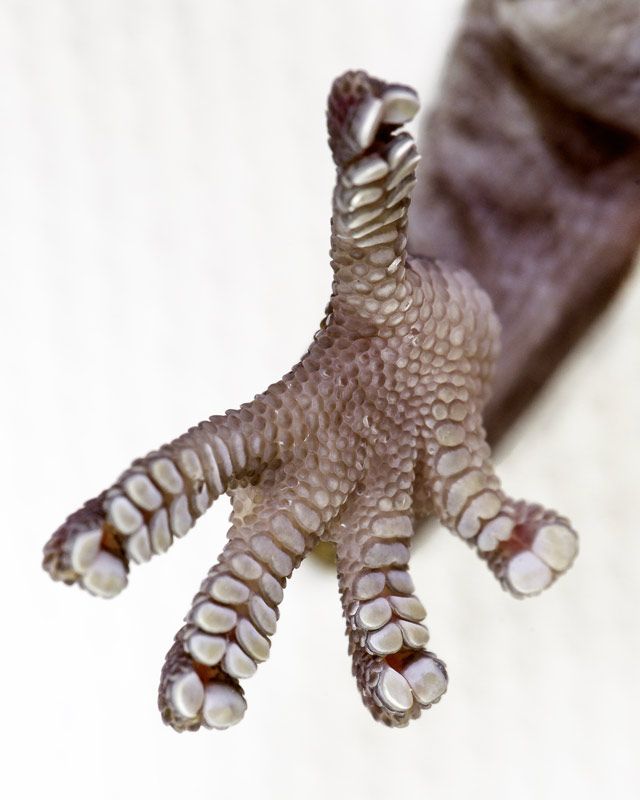The fascination with the ability of geckos to scamper up smooth walls and hang upside down from improbable surfaces has entranced scientists at least as far back as Aristotle, who noted the reptile's remarkable feats in his History of Animals.
But it wasn't until about 15 years ago, when researchers were definitively able to attribute the gecko's powers of adhesion to nanoscale threads in the gecko's toes, that the practical possibilities of biomimicry at microscopic levels caught the imagination of researchers in earnest.
Now, a Lehigh-led team is collaborating with Michelin Corporation and the National Science Foundation to develop materials with surface architectures that could improve the safety and reliability of tires. The NSF's Grant Opportunities for Academic Liaison with Industry (GOALI) program is designed to enable firms to "kick the tires," so to speak, on academic research that could have significant impact upon their industry and society at large.
Anand Jagota, professor of chemical and biomolecular engineering and director of Lehigh's bioengineering program, has been a leading researcher in biomaterials, biomechanics, and nanobiotechnology close to three decades; before joining Lehigh, he was engaged in similar research endeavors with duPont Corporation. Over the course of his career, he's developed a deep focus in applying biomimetics to improve the adhesive and mechanical properties of rubbery materials.
Jagota his team recently published a paper in Scientific Reports, a journal of the Nature Publishing Group, which outlines their work creating new bio-inspired film-terminated structures with unique friction characteristics that could have positive industrial implications for, among other things, tires. The paper, "Strongly Modulated Friction of a Film-Terminated Ridge-Channel Structure," was co-written by Jagota and lead author Zhenping He along with Ying Bai, Chung-Yuen Hui of Cornell University and Benjamin Levrard, a researcher at Michelin Corporation.
Jagota and Hui's biomimetic work caught the eye of Michelin when early results were reported at a conference in France several years ago, and the collaboration is now in full swing.
For tires, there is a classic performance conundrum among traction, tire life and fuel efficiency.
Improving one quality almost always degrades another.
"High quality tires minimize rolling resistance, which improves fuel efficiency, while maximizing the sliding friction that basically helps to brake quickly," says Jagota. "To help increase this sliding friction, tires currently employ millimeter-scale structures to grip the road and channel water. We are working to create structures at the microscale that will enhance friction and adhesion control."
Rather than emulating the hairy fibrils that grace gecko toes, Jagota and his colleagues are looking to the smooth pad surfaces found on the feet of grasshoppers or frogs. In a precursor to the current study, the team developed a thin film comprised of an array of tiny pillars on top of a substrate.
"We placed these pillars or posts in an hexagonal array and covered them with a thin coating that allowed them to make solid contact with rough surfaces and strongly enhances static friction," says Jagota. "Dragging the film in any direction provided the same friction. But tires don't require the same properties in all directions, so we went to an array of parallel ridges. We believed this would provide greater resistance to sideways movement across the film - and greater sliding friction."
They were right, but the magnitude of the results surprised the team. The parallel ridges created a surface where the "good" lateral sliding friction was increased significantly.
"This was the most unexpected thing: in the ridge-channel geometry, the film improved sliding friction dramatically, by a factor of three or four," Jagota says.
In the experiment, the researchers created a film using rubber-like material which had rows of evenly spaced, parallel ridges, covered with a thin topcoat. With the film laid flat, a glass ball was pressed into the film and dragged across it in a direction perpendicular to the ridges.
According to the team, the increased sliding friction is due to extreme contortion of the ridges. Under the pressure of the sphere, the ridges stretched and rode up on each other, creating broad areas of surface and internal contact. This internal sliding allowed unwanted energy to be released. Additionally, elastic energy that was soaked up during the contortion was then liberated as the ridges sprung back to their normal form.
The results are promising. Increased sliding friction could enhance a tire's grip, as forward energy is released from the tire's surface to dissipate as harmless heat and sound waves. With no commensurate increase in adhesion observed, rolling resistance should not be markedly increased.
The NSF's GOALI grant will fund the team's ongoing efforts for three years.
"This has been a very fruitful collaboration already," says Jagota. "We are still in the early stages, but the collaborative support from Michelin and the NSF is making it possible for us to put nature's designs to work on the highways."
Top photo courtesy of ©Svedoliver | Dreamstime



